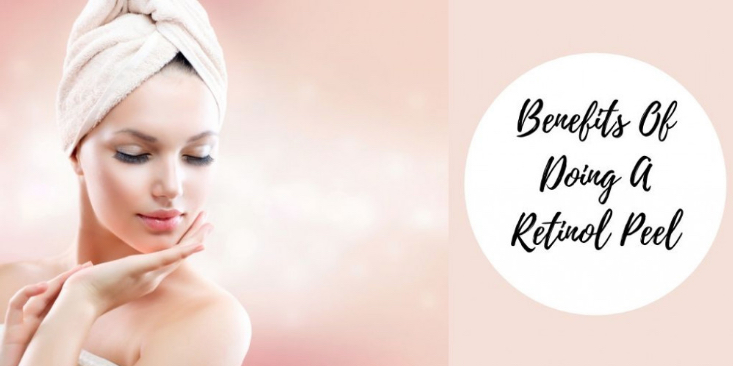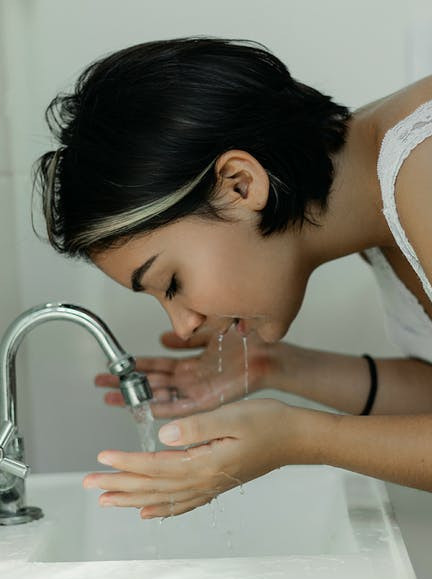Retinol, and the term “anti-aging,” go together like a hand in a glove. You can’t separate the two. If you just used retinol and sunscreen, you’d have covered a lot of bases in regard to how your skin ages. There are a number of ways to use retinol, including moisturizing lotions, eye creams, anti-aging serums, and peels, the latter of which will be the topic for this post. Here’s why you should consider doing a retinol chemical peel.

Table of Contents
What Are Retinoids?
Understanding what retinoids are will give you better clarity into what retinol is and how it functions. Retinoids are natural derivatives of vitamin A, and a primary ingredient in anti-aging skincare products. In fact, our skin contains receptors for retinoids.
Retin-A, also called retinoic acid, is a pharmaceutical retinoid that has been used to treat acne for 40 years. It’s also used for treating the visible signs of aging, and is a prescription-only product sold under the generic name, tretinoin.
Other retinoids you’ve probably heard of are adapalene, used for acne, and Accutane, an oral retinoid that now carries an FDA-issued black box warning due to the serious reactions and complications associated with its use.
Retinol is the natural, pure form of vitamin A and is a precursor to tretinoin, the active ingredient in Retin-A. It’s converted to retinoic acid in the skin via an enzymatic process. Retinol is less irritating and has fewer side effects than Retin-A, and can be purchased over-the-counter in concentrations of 0.5% to 2.5%.
Retinol yields such great results as an anti-aging ingredient because of its ability to penetrate the outermost layer of the skin, where it can exert it’s effect on elastin and collagen, the primary structural proteins contained within the dermis. Retinol’s superior penetration is due to its small-molecular structure.
A Bit About Collagen and Elastin
Elastin and collagen are found in the extracellular matrix of connective tissue, including the skin, bones, cartilage, muscles, and tendons. They’re produced by fibroblasts, the principal cells in connective tissue. Collagen is found in the deeper layers of the dermis, whereas elastin is found in the middle to upper layers.
Hyaluronic acid, a glycosaminoglycan molecule, that helps in the retention of collagen and moisture, is found in both the epidermis and dermis. Concentrations of hyaluronic acid decline with age, particularly in the dermal layer where wrinkles form. The reason a substance is considered anti-aging is because of its favorable impact on collagen and elastin.
Collagen plays a crucial role in keeping the skin strong and firm. Think of it as the glue that holds the body together. Visualize a baby’s plump, radiant skin, then picture an 80-year old’s skin. That’s the power of collagen. Thicker, stronger, more elastic skin, not only looks young, but is less likely to show signs of aging.
Matrix Proteins
The best way to think of elastin, another key structural protein found in the skin, lungs, blood vessels, and connective tissue, is to visualize how elastic stretches and bounces back. That’s essentially the role elastin plays in the skin.
Elastin enables your skin to stretch – think smiling, laughing, and frowning – but then resume it’s original position. Elastin gives skin bounce and elasticity. It’s found in much lesser amounts in the skin than is collagen.
Collagen and elastin work together to strengthen the skin, while keeping it resilient, soft and pliable. Sadly, collagen and elastin decline with age. Sunscreen is so essential if you want to age well, because UV radiation breaks down collagen and elastin, causing premature aging.
Aging, smoking, free-radical damage, and pollution all negatively impact matrix proteins. Retinoids work so fabulously because of their ability to stimulate the production of these fundamental proteins that are critical to the integrity of the skin.
Retinol Chemical Peel Benefits
Retinol has an impressive line up of benefits. It promotes cell turnover, strengthens and tightens the skin, has antioxidant properties to fight free-radical damage, and keeps the skin looking younger longer. Other benefits include:
- Stimulates the production of collagen and elastin
- Retains moisture in the skin
- Promotes the turnover and regeneration of new skin cells
- Diminishes the appearance of fine lines and wrinkles
- Thickens the dermal layers of the skin
- Reduces hyperpigmentation and age spots
- Smooths skin tone
- Tightens and unclogs pores
- Evens out texture
- Rejuvenates a dull complexion
Are There Any Side Effects?
The side effects of a retinol peel can range from redness, peeling and flaking, to increased sensitivity. Peels will make your skin more sensitive to the sun so be diligent in always wearing sunscreen, along with a broad-brimmed hat.
These precautions should be a matter of course, but even more so when using any products containing retinoids or alpha-hydroxy-acids. It’s normal to experience mild side effects when first using retinoids, and will usually resolve within a week or two.
Chemical Peels

A chemical peel is a cosmetic treatment that uses chemicals with a low pH to remove the top layer of skin, revealing younger-looking skin beneath.
This exfoliation and peeling process reduces fine lines and other imperfections, while evening out skin tone and smoothing the complexion.
A number of chemicals are used for cosmetic peels, such as TCA, salicylic acid, fruit enzymes, and peels that use alpha-hydroxy-acids, including glycolic, lactic, mandelic, and citric acids.
Peels are safe and can be done every four to six weeks, but how often you do them is generally dependent on your skin type and the strength of the peel, which can range from superficial to deep.
You’ll see more peeling, and for longer durations, with stronger peels. Chemical peels can be done at spas, salons, clinics, or at a dermatologist’s office, and are often performed in conjunction with facials and microdermabrasion.
You can also do peels yourself at home. Anyone who wants to enhance their appearance can enjoy the benefits of a chemical peel, even those with sensitive skin.
[Read More: The Benefits of Glycolic Acid]
[Read More: 7 Reasons To Do A Mandelic Acid Peel]
Retinol Peels
Now to the fun part. Make sure to not use any scrubs, masks, self-tanners, or retinol products 48 hours before doing your peel. Also, don’t wax or shave. If you have any open breakouts, wait until they’ve healed to do a retinol peel. Heed this sound advice because it will hurt like crazy to put acid on an open wound.
Retinol peels use an alpha-hydroxy-acid as the peeling agent. I personally like glycolic acid, derived from sugarcane, because it has the smallest molecular size of all the AHAs, which means it’s able to penetrate deeply into the skin. Plus, people tolerate it well. If you have sensitive skin, start with a peel that has a lower to medium-strength concentration, such as 20-30%.
I use a 40% and 50% glycolic acid peels, but I’m familiar with how my skin reacts. You can gradually work your way up to medical-strength concentrations of 70%, but you’ll want to stick with lower concentrations in the beginning, slowly increasing the time you leave the peel on. You can then progress to higher-strength peels if you’re confident your skin can handle it.
How To Do A Retinol Chemical Peel
1. Wash and tone your face. You can use a cotton ball and rubbing alcohol to tone your face.
2. To be extra cautious, put a dab of vaseline underneath your eyes, on your lips, and on your nostrils. These areas are delicate and you don’t want to burn them. They also don’t have as many sebaceous glands so they’ll burn easier.
3. Fill your bathroom sink with cold water. I like adding a handful of ice cubes to make the water extra cold. Pour a tablespoon or so of baking soda in the sink. This will neutralize the solution, and trust me, you’ll want it neutralized.

4. Carefully apply the solution (peels are liquid) using a cotton ball. Thoroughly cover all areas of your face, avoiding the areas mentioned above. Don’t be alarmed if it burns, because it will.
Use a fan to blow cold air on your face if it’s too uncomfortable. The time limit is going to vary anywhere from 30 seconds to two minutes.
How Long Should I Leave It On?
I would advise leaving the peel on for only 30 seconds if you’re a novice. If not, aim for two minutes. ALWAYS time your peel. It’s easy to get distracted and leave it on too long.
5. When your timer rings, dunk your entire face in the sink of cold water, and keep dunking, until the stinging stops. Gently pat your face dry. Your skin will be red and will still sting a little.
6. Now it’s time for some magic. Slather on two heavy layers of a high-quality retinol cream, which will soothe and cool your face. Give yourself a shout out, you just did something amazing for your skin
Stay out of the sun for one week following your peel. After that, alway use a sunscreen with a high SPF, which you should be doing anyway. Your skin may feel extra dry a few days following your peel since the top layer of skin was removed. Liberally apply a moisturizer twice a day to combat this dryness.
7. Repeat this process every four to six weeks for a total of six to eight peels to yield the best results. Remember, the results are cumulative so don’t be disappointed if the first couple of peels don’t give you the results you were hoping for. However, I’ve always noticed improvements after each peel. A retinol chemical peel should be done in conjunction with a consistent skincare routine.
Retinol Recovery Peel Facial Masks
Here’s another way to perform a peel at home using Dr. Dennis Gross’ ferulic and retinol recovery peel facial masks. Using prepared masks requires less steps, and are gentle, yet effective.
Begin by:
1. Thoroughly washing and toning your face.
2. Unwrap the pad (mask) and apply it to your face. It’s completely normal to feel a slight tingling and burning sensation. This means the active ingredients are doing their job.
3. Do not rinse, the product was formulated to absorb into the skin overnight.
4. Repeat the process twice a week. How easy is that?!
5. Don’t forget to always use sunscreen and stay hydrated! As with any peel, you’ll notice incremental improvements in your skin with repeated use.
Key Points
If your complexion is dull and lackluster, and you’re noticing more fine lines and dark spots, it may be time for a peel. A retinol chemical peel is a tremendous way to brighten and rejuvenate. Kind of like a tune-up for the skin.
With so many great products on the market, it’s never been more cost-effective and convenient to do peels right in the comfort of your own home.
Have you heard of a retinol chemical peel? Have you ever done one? Let me know in the comments:)
References:
(1) Drug Enquirer: Accutane Side Effects and Warnings
(2) Medical News Today: what is collagen, and why do people use it?
(3) U.S. National Library of Medicine: Hyaluronic Acid
(4) NCBI: Collagen: The Fibrous Proteins of the Matrix
(5) NCBI: The structure and micromechanics of elastic tissue

Many thanks to you for sharing such an excellent article with us. I am keen on the topic of skincare and want to know more about how we can keep our skin smooth. This is a very important post for that reason. Almost all types of products have side effects, but I know very little about retinol. I will share this post with my wife so she can get good results with a chemical peel. Thank you. Interesting article!
Thank you for reading and leaving a comment. Skincare is an interesting topic. We are all aging every day, so finding ways to keep our skin looking youthful is important. I appreciate you sharing my article with your wife.
Retinol exfoliation is an investment in you, and maintaining proper routine care can help make that investment worthwhile. Like any chemical exfoliator, retinol exfoliation works by penetrating several layers of the skin, promoting healing and rejuvenation from within. Protecting your skin from the environment in the days after exfoliation ensures that this process is safe and effective. Thanks for the post.
Yes, anything you do for your skin is certainly an investment, whether that be doing chemical peels every month, using retinoids to keep your skin looking younger longer, and setting up a skincare routine and sticking to it. Being consistent in these areas will translate to fabulous looking skin. Thanks so much for reading:)